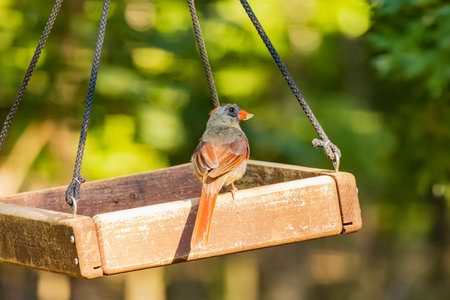1. Understanding UV Light and Vitamin D
When it comes to the health and vitality of birds, the importance of ultraviolet (UV) light and vitamin D cannot be overstated. Birds, just like humans, rely on exposure to natural sunlight to help their bodies synthesize vitamin D—a nutrient critical for bone strength, immune function, and overall wellbeing. The science behind this process is fascinating: when birds bask in sunlight, UVB rays penetrate their feathers and skin, triggering a chemical reaction that converts precursors in their preen oil into active vitamin D3. This transformation is unique to avian species and highlights how closely tied their health is to their natural environment. Without sufficient UV exposure, birds may develop deficiencies that lead to weakened bones, poor feather quality, and increased susceptibility to illness. Understanding this interplay between light and nutrition gives us valuable insight into how to better care for both wild and pet birds, especially in environments where natural sunlight is limited.
Birds Natural Behavior and Sunlight
Wild birds have evolved remarkable instincts when it comes to seeking out sunlight, using it as a vital resource for maintaining their health. Whether it’s early morning songbirds basking on tree branches or parrots preening under the midday sun, these natural behaviors are directly tied to their need for UV light exposure. In their native environments, birds instinctively know when and how long to sunbathe, which helps them synthesize vitamin D—a crucial nutrient that supports bone strength, immune function, and overall vitality.
Habitats play a big role in shaping how much sunlight birds receive. For example, forest-dwelling species may catch filtered rays through the canopy, while grassland or desert birds are exposed to more direct sunlight. This variety in natural settings means that different species have adapted unique sun-seeking habits. These adaptations ensure they get just the right amount of UV light without risking overexposure or deficiency.
Natural Sun-Seeking Behaviors by Habitat
| Habitat | Typical Bird Behavior | UV Light Exposure |
|---|---|---|
| Forest | Basking in sun patches, moving between shade and light | Filtered/Moderate |
| Grassland | Extended sunbathing during cooler hours | Direct/High |
| Wetlands | Sunning on open reeds or floating vegetation | Variable/Moderate |
| Desert | Short bursts of sun exposure, retreating to shade quickly | Intense/Brief periods |
The Importance of Observing Wild Birds
By studying how wild birds interact with their environment and use sunlight, we gain valuable insights into what pet and captive birds require for optimal health. These observations highlight the importance of replicating natural UV light conditions to support the same physiological benefits that wild birds enjoy in nature.

3. Vitamin D Deficiency in Pet Birds
Vitamin D deficiency is a surprisingly common and often overlooked health concern for pet birds, especially those living indoors across the United States. Identifying a shortage of vitamin D isn’t always straightforward—birds are masters at masking early symptoms until issues become severe. Some of the most noticeable signs include lethargy, poor feather quality, soft or misshapen beaks and bones, decreased appetite, and frequent illness due to a weakened immune system. In young or growing birds, you might see stunted growth or developmental delays.
Risks Associated with Indoor Living
One major reason vitamin D deficiency is so prevalent among American pet birds is their limited access to natural sunlight. Unlike their wild counterparts that bask in UV-rich daylight, many companion birds spend the majority of their lives inside homes where window glass blocks most beneficial UVB rays. Without this exposure, their bodies can’t synthesize enough vitamin D3—an essential nutrient for calcium absorption and overall health. Even if a bird’s diet seems complete, nutritional supplements often fall short without adequate UV light to activate the vitamin D pathway.
The Hidden Danger: Why Vitamin D Shortages Matter
The dangers of vitamin D deficiency can lurk beneath the surface for months or even years before serious problems arise. Chronic shortages put birds at risk for metabolic bone disease, weakened immunity, egg-laying complications, muscle tremors, and even sudden death from hypocalcemia (low blood calcium). For many American pet owners, these risks remain hidden because early symptoms can be mistaken for behavioral issues or aging. That’s why understanding the link between UV light exposure and vitamin D production is crucial—especially in climates where birds are kept indoors year-round or during long winter months.
4. UV Lighting Solutions for Pet Owners
For bird owners in the United States, providing the right type of UV light indoors is essential for supporting your feathered friends health and well-being. While natural sunlight is ideal, indoor birds rely on artificial lighting to meet their needs. Below are practical tips to ensure your pet receives safe and effective UV exposure, along with guidance on choosing bulbs, setup strategies, and clearing up some common misconceptions.
Choosing the Right UV Bulbs
Not all bulbs marketed as “full-spectrum” or “daylight” provide adequate UVB rays needed for vitamin D synthesis. Look for bulbs specifically labeled for avian use that emit both UVA and UVB wavelengths. Here’s a quick comparison of popular options:
| Type of Bulb | UVA/UVB Output | Lifespan | Best For |
|---|---|---|---|
| Fluorescent Tube (T5/T8) | Good UVA/UVB balance | 6-12 months* | Cages & aviaries |
| Compact Fluorescent | Moderate UVB output | 6-8 months* | Small cages or single perches |
| Mercury Vapor Bulb | High UVA/UVB output | 12 months* | Larger indoor bird rooms (with caution) |
*Replace bulbs every 6-12 months even if still producing visible light, as UV output declines over time.
Setting Up Your Birds Lighting System
- Distance Matters: Position the bulb 12-18 inches above your bird’s main perch. Too close can cause burns; too far reduces effectiveness.
- No Glass or Plastic: UVB rays don’t penetrate glass or acrylic, so avoid barriers between the bulb and your bird.
- Sufficient Exposure: Aim for 4-8 hours of daily exposure, simulating natural cycles with a timer for consistency.
- Diversify Perching: Offer shaded areas within the cage so your bird can self-regulate its exposure, just like it would outdoors.
- Monitor Behavior: Watch for signs of discomfort or avoidance—some birds need gradual introduction to new lighting setups.
Busting Common Myths About Indoor UV Lighting
- “Regular room lights are enough.”
Ordinary household bulbs do not emit beneficial UVB rays necessary for vitamin D production. - “More UV is always better.”
Overexposure can be harmful, potentially causing eye or skin issues. Balance is key. - “Any full-spectrum bulb works.”
Only bulbs designed for reptiles or birds and labeled with specific UVB percentages are suitable for avian health needs. - “Sunlight through a window counts.”
Glass blocks almost all UVB rays—direct outdoor sunlight or proper artificial UV lighting is required.
The Takeaway: Design with Bird Behavior in Mind
A well-designed lighting environment supports both the physical and psychological health of indoor birds. By selecting high-quality avian-specific bulbs, positioning them thoughtfully, and respecting your birds natural instincts to seek shade or sun, you’ll be nurturing habits that echo life in the wild—right in your living room.
5. Adapting Care to U.S. Climates and Lifestyles
Across the United States, bird owners face unique challenges shaped by their local environment and daily routines. Regional differences—such as city living, suburban spaces, or rural expanses—play a huge role in how pet birds receive UV light and synthesize vitamin D. For example, urban apartment dwellers often have limited access to direct sunlight due to building layouts and smaller windows. This means that relying on natural sunlight alone may not be practical for ensuring optimal vitamin D synthesis in birds.
Urban Living: Navigating Limited Sunlight
Many Americans live in cities where outdoor space is at a premium. High-rise apartments and shaded courtyards can restrict a bird’s exposure to natural UVB rays, making it crucial for owners to invest in high-quality UVB lamps designed specifically for avian health. Regularly rotating cage placement near sunlit windows (while being cautious of overheating) can help, but artificial UV lighting often becomes the safest and most reliable solution.
Seasonal Shifts: Adjusting to Changing Daylight
The U.S. experiences significant seasonal variation, especially in northern states where winter days are short and daylight is weak. During these months, both indoor and outdoor birds may be at risk for vitamin D deficiency. Owners should increase the use of artificial UVB sources from fall through spring and consider diet adjustments with veterinarian guidance if sunlight exposure is lacking.
Lifestyle Habits: Suburban Versus Rural Considerations
In suburban settings, homeowners might have more flexibility to let birds enjoy screened porches or aviaries during warm months, provided they’re protected from predators and temperature extremes. Rural bird keepers often benefit from even greater outdoor access, but should remain vigilant about overexposure during peak summer hours when UV intensity can lead to overheating or stress.
Personalizing Vitamin D Strategies
Ultimately, bird owners across America need to tailor their approach based on climate, housing style, and lifestyle patterns. Whether you’re managing a parrot’s needs in a downtown loft or caring for finches on a country farmstead, understanding your local environmental factors—and how they affect your bird’s access to UV light—ensures healthier, happier pets year-round.
6. Balancing Sunlight, Diet, and Safety
Ensuring your pet bird thrives means finding the right balance between natural sunlight, supplemental UV lighting, and a well-rounded diet. Each factor plays a crucial role in supporting vitamin D synthesis and overall health—but it’s important to approach this balance thoughtfully.
Maximizing Natural Sunlight Safely
Whenever possible, allow your bird access to unfiltered natural sunlight. A screened-in porch or time outside in a secure cage can be ideal for short periods. Remember, window glass blocks most UVB rays, so indoor sunbathing won’t suffice for vitamin D production. Always supervise outdoor time closely to protect your bird from predators, overheating, and escape.
Using UV Lamps Effectively
For many American bird owners, year-round natural sun exposure isn’t practical. Quality avian-specific UV lamps are designed to mimic the beneficial spectrum of sunlight, including essential UVA and UVB rays. Place lamps at an appropriate distance (as recommended by manufacturers), and replace bulbs regularly—most lose effectiveness after six months even if they still light up. Avoid using reptile lamps; they may not be safe for birds.
Optimizing Dietary Vitamin D
Even with ample light exposure, diet matters. Commercially formulated pellets typically contain balanced levels of vitamin D3—unlike seed-only diets, which can lead to deficiencies. Supplement fresh fruits and vegetables as treats, but ensure pellets make up the bulk of meals unless otherwise directed by an avian vet. Over-supplementation of vitamin D can be harmful, so stick to reputable foods and avoid unnecessary additives.
A Holistic Approach: Monitor and Adjust
No single method guarantees perfect health; instead, observe your bird’s behavior and physical condition as you refine their care regimen. Look for signs of wellness like smooth feathers, active engagement, strong appetite, and good posture. Schedule regular check-ups with an avian veterinarian—they’ll help tailor sunlight, lighting, and dietary plans to your bird’s unique needs.
Prioritizing Safety Above All
Whether basking in sunlight or enjoying time near a UV lamp, always prioritize your bird’s safety. Never leave them unattended outdoors or exposed to direct midday sun without shade options. Ensure all lamps are securely mounted and cords safely out of reach. By combining thoughtful use of natural and artificial light with expert-approved nutrition, you’re setting the stage for a vibrant, healthy life for your feathered friend.


